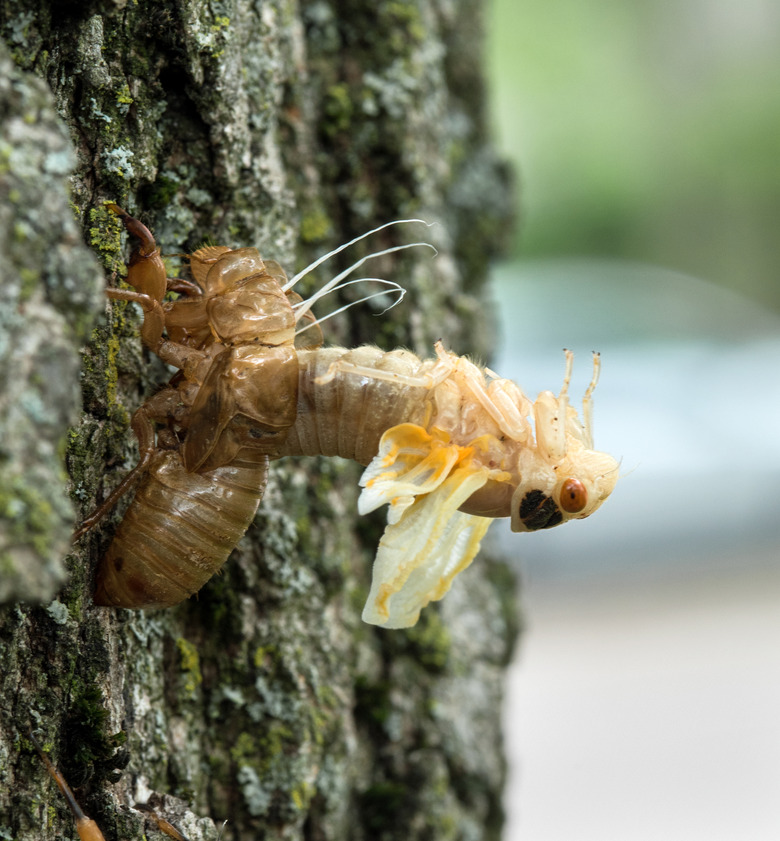How To Identify Bugs That Shed Their Skins
Insects follow two types of developmental stages. Incomplete metamorphosis, when the larval stages look like miniature versions of the adults, and complete metamorphosis, when the larval stages have a different form than the adults, like caterpillars transforming into butterflies. During metamorphosis, bugs shed their skin as they grow from larvae to adulthood.
Bugs or Insects?
Bugs or Insects?
All bugs are insects, but not all insects are bugs. Many people refer to all insects and other land-dwelling arthropods like spiders as bugs. Technically, true bugs are insects that belong to the order Hemiptera. Bugs are characterized by their piercing mouthparts that suck in fluids like a straw. These mouthparts are contained in a structure called a rostrum, and when they're not feeding, it is usually tucked up underneath their body.
There are more than 80,000 different bug species in the order Hemiptera. Examples of true bugs include cicadas (Cicadoidea), leafhoppers (Cicadellidae) and shield bugs (Pentatomidae).
Many true bugs are considered pest species. For example, aphids (Aphidoidea) are deemed agricultural pests because they breed rapidly and large infestations can kill a plant and damage crops. However, some bugs, like bed bugs (Cimex lectularius), are pests because as their name suggests, they infest beds and feed on humans' blood in the night, causing itchy bites or more serious problems if a person is allergic to them.
Bug Metamorphosis
Bug Metamorphosis
True bugs follow an incomplete metamorphosis developmental cycle. After they hatch, they are called nymphs in their larval stage. Nymphs look like small versions of their adult form except they lack genitals and wings.
All bugs shed their skins but only during their juvenile stages. Their skins, called exoskeletons, are mostly made up of a hard material called chitin. Their exoskeleton provides structure in the same way that bones do for humans except on the outside of their bodies. Because it's so hard, bugs need to shed their skins, called molting, during their nymph stages because the exoskeleton doesn't grow with them. Once they are fully grown, they no longer need to molt because they stop growing.
The time between each molting stage is called an instar. Bugs transition through many instars while they are nymphs. The bug develops new organs and wing structures during each instar to get closer to its adult form.
Bugs Shedding Their Skin
Bugs Shedding Their Skin
Before molting, the bug consumes more oxygen than needed and then holds its breath. The extra air helps expand the body of the bug to crack open the exoskeleton so the bug can crawl out. For a short time after they shed their skin, the bugs' soft body is left exposed, and they are unable to breathe. This is because the structures they use for breathing, called tracheoles, are found across their body and are unusable while detached from their exoskeleton.
The vulnerable bug typically has a white, soft body as it is the protective outer exoskeleton that gives it its colors and patterns. After molting, their skin quickly hardens again to form a new, larger exoskeleton, but during this time, they often don't move far because they are more at risk of predators. The bug then leaves its empty shell behind.
Cicada Skin Shed
Cicada Skin Shed
Cicadas are a great example of bugs that shed their skin because their discarded exoskeletons are easily found clinging to the sides of trees. During their nymph stage, cicadas live underground, sucking tree sap. When the environmental conditions are right, which can take up to 17 years, they crawl out of the ground, up a tree and shed their final exoskeleton. Their back splits open and a white bug nearly twice the size of the exoskeleton it was in emerges and unfurls its wings. The entire molting process takes about an hour until the cicada is ready to crawl away.
References
- Science: Insect Molting Is 'Like Having Your Lungs Ripped Out'
- Biological Journal of the Linnean Society: Why Do Adult Insects Not Moult?
- Michigan State University Pesticide Education: Insects
- Te Papa Museum of New Zealand: What Is a Bug? Insects, Arachnids, and Myriapods
- Arizona State University: Ask a Biologist: True Bugs
- National Geographic: Cicadas, Facts and Photos
Cite This Article
MLA
Jerrett, Adrianne. "How To Identify Bugs That Shed Their Skins" sciencing.com, https://www.sciencing.com/how-to-identify-bugs-that-shed-their-skins-12363071/. 30 September 2021.
APA
Jerrett, Adrianne. (2021, September 30). How To Identify Bugs That Shed Their Skins. sciencing.com. Retrieved from https://www.sciencing.com/how-to-identify-bugs-that-shed-their-skins-12363071/
Chicago
Jerrett, Adrianne. How To Identify Bugs That Shed Their Skins last modified August 30, 2022. https://www.sciencing.com/how-to-identify-bugs-that-shed-their-skins-12363071/
